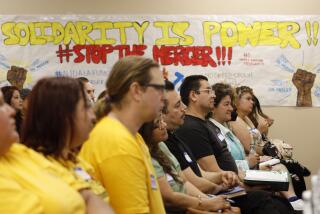Pick-and-Shovel Free Enterprise : Soviet Union: Coal miners, struggling for a better life, are deeply politicized. But as they cross uncharted ground their ranks are split, so battles rage.
- Share via
At two meetings next week in the Soviet Union, the fate of Soviet workers may be decided. The first will be the Second Congress of Soviet Miners, Monday in Donetsk, in the heart of the Donbass mining region in the eastern Ukraine. The second, two days later in Moscow, will be the government-controlled All-Union Central Council of Trade Unions, which has reigned supreme over Soviet workers for decades.
“Communism isn’t going to bring us that bright future we were promised,” exclaimed a delegate at the First Congress of Soviet Miners in June. “We demand the creation of a government that will provide for a transition to a free-market economy and will guarantee democracy.” These words appeared in one of the resolutions approved by nearly 800 coal miners who attended the June congress in Donetsk. Delegates to the miners’ congresses represent virtually the entire 2-million work force of the Soviet coal-mining industry.
These are the same miners who staged a paralyzing nationwide coal strike last year, in which nearly half a million workers took part. But, whereas last summer the coal miners’ demands were mainly economic, this year they are blatantly political. The miners are going for the jugular of Communist power. They are becoming politicized and organized, and are beginning to wield political clout.
Their first objective is to gain power through elective office. They are running on every possible level of Soviet political life, and whenever it is impossible to put up their own candidates, they support those who are ready to make a strong commitment to the workers’ cause.
In Donetsk, out of the 150 members of the City Council, 49 are miners, and one of the co-chairmen of the Donetsk City Strike Committee, Alexander Kolomiytsev, is also a member of the City Council’s ruling Presidium.
The miners’ second objective is economic self-reliance. In the Kuzbass basin of western Siberia, for instance, where the first spark of last year’s two-week strike was ignited, the miners are not only exerting not only political influence, but are also trying to gain economic control of the region. Vyacheslav Golikov, chairman of the Council of Workers’ Committees of Kuzbass, is actively working with a free-market economist, Mikhail Kislyuk, to transform the mineral-rich Kuzbass basin into an economically sovereign region.
Kislyuk’s detailed economic blueprint includes the elimination of all industrial ministries in the Kuzbass area, creation of an independent taxation and financial system and self-management of enterprises by the workers. “They can buyout, rent, lease or become stockholders in their own companies,” he told me with great relish.
Similar plans are being drawn up in Sakhalin, Vorkuta, Inta and other mining areas. “We are producing the coal and we want to sell it ourselves,” is a remark I often heard at the miners’ congress in Donetsk.
However, the miners face immense stumbling blocs in their attempts to become economically independent. “Free-market economy” and “free enterprise” have become popular buzzwords in the Soviet Union, but no one really knows what they mean or how to apply them.
And not all workers’ committees are democratic in their orientation. Some are creatures of the local Communist Party apparatus, and the reactionary-minded workers in these groups are literally at war with the predominantly democratic workers’ committees that emerged as a result of last year’s national coal strike. Deeply ingrained conservative behavior, fostered by 72 years of relentless totalitarian, paternalistic rule, has not been eradicated from the souls and psyches of all Soviet workers, especially the older generation.
There is also an intricate web of hand-outs called podachki and a system of falsely recording overfulfillment of norms, called prepiski, which are still at the disposal of Soviet factory foremen, and to which many Soviet workers continue to be tied by an umbilical cord not easily severed.
Historically, coal miners have always been the “bloom of the working class” in Russia, and today they are in the forefront of the workers’ movement, but their struggle is far from won.
The third major goal of Soviet coal workers is to forge bridges to the mainstream democratic movement in the country. Just as in Poland, where workers allied themselves with leading intellectuals and created a structure to which the communist regime eventually had to cede power, many Soviet workers now also realize that “without links to the democratic intelligentsia, the workers’ movement has no future.” That conclusion appeared in a remarkable declaration issued this spring at a large workers’ conference in Novokuznetsk, the major coal mining city in the Kuzbass region.
An organization called the Confederation of Labor emerged out of that conference, which, like Poland’s Solidarity, hopes to unite under its umbrella the myriad independent workers’ committees, clubs and fledgling trade unions that have sprouted all across the Soviet Union, like mushrooms after a heavy rain.
But the sheer size of the country and the traditional schism between workers and the intelligentsia that has prevailed for generations also pose serious obstacles. The emergence of a Solidarity movement in the Soviet Union at the present time is highly problematic, in the face of the many centrifugal forces that are tearing the country apart.
One of the main items on the agenda at next week’s Second Congress of Soviet Miners will be the creation of a new miners’ union, independent of the All-Union Central Council of Trade Unions. In realistic terms, organizing such a union won’t be easy. The council holds the purse strings. Its coffers are constantly replenished by workers’ dues, and these funds are used to provide workers with sick leave, pensions, vacation vouchers and other amenities. The official trade union will not easily give up this money and the power that goes with it.
Painfully aware of the Soviet workers’ increasingly rebellious mood, the council is championing the cause of the more conservative workers who fear change. At the same time, the official trade-union organization is trying to paste a brand new facade on its old structure. At its conference next week, the council plans to assume a new name: “Confederation of Independent Trade Unions of the U.S.S.R.”
However the fate of Soviet workers is finally resolved, this fall we can expect a fierce battle for their very souls.
More to Read
Sign up for Essential California
The most important California stories and recommendations in your inbox every morning.
You may occasionally receive promotional content from the Los Angeles Times.













